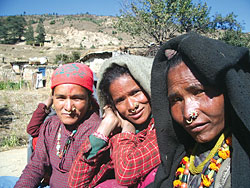|
|
Over the past decade, as pregnancy-related deaths have fallen worldwide at a frustratingly slow rate of one per cent a year, according to the World Health Organisation, Nepal has managed to cut its maternal mortality rate by almost 50 per cent.
It has done so without adding expensive emergency surgical delivery teams, once seen as the only effective way to cut the rural death rate. Instead, it has focussed on more routine interventions - teaching about birth control, giving iron supplements to cut anaemia, encouraging later motherhood and providing safe abortions, among others.
"A lot of progress has been made here," said Birthe Locatelli-Rossi, chief of the health section for UNICEF in Nepal. "There's an international belief you can't fix this problem except with emergency obstetric units. No doubt those are really needed, but there are other things to do too."
Nepal is an exception in South Asia, which, along with sub-Saharan Africa, has the highest rates of maternal mortality in the world, according to a report released in October by the World Bank, World Health Organisation and several UN agencies.
Together, sub-Saharan Africa and South Asia account for 85 per cent of the world's maternal deaths. Afghanistan is tied with Sierra Leone as the most dangerous place to become pregnant - with one in six women dying as a result of pregnancies - and death rates are high in Pakistan, India and Bangladesh as well.
But from 2001 to 2006, a government and NGO-funded campaign to increase access to family planning information and contraceptives and to encourage women to wait until age 20 to have a first child has cut Nepal's birth rate from 4.1 children per woman to 3.1, reducing maternal deaths as the number of lifetime pregnancies falls.
Because many rural women give birth in less-than-sterile environments, agencies combatting maternal mortality have beefed up the country's tetanus vaccination campaign, which has led to a drop in deaths of both mothers and newborns. Pregnant women who make at least one prenatal visit to a doctor also are given iron supplements to cut anaemia, once a major contributor to fatal haemorrhaging after delivery.
Today just a third of Nepali women are anaemic, down from 75 per cent five years ago. Vitamin A supplements, given after birth to boost immunity, similarly have reduced infections in new mothers. Through education campaigns and expanded clinic networks, Nepal also has managed to boost births at hospitals from 10 per cent to 20 per cent of the total, and increase the number of postnatal visits to clinics by more than 30 per cent.
Three years ago the country legalised abortion and made it available at 85 per cent of district hospitals, dramatically cutting illegal abortions that were once one of the major sources of maternal deaths. But Nepal is still struggling to get help to the five per cent of Nepali women who need a Caesarean section to deliver their babies.
Because young wives are generally the lowest-ranked members of an extended family household, and women's health is not a priority in rural areas, many pregnant women are taken to a clinic only after days of unsuccessful labour, at which point most die en route to a hospital or on arrival.
Worse, because a Caesarean can cost $140, a fortune in rural Nepal, some husbands prefer to save the money and let their wives die, health workers say.
More help is on the horizon for Nepal's rural women, however. A new study in a few districts indicates that delivering a few oral drops of an easy-to-use drug called mistoprostol, which doesn't need refrigeration, appears to have reduced likely deaths of women from postpartum haemorrhage by 85 per cent.
(Laurie Goering/Chicago Tribune)



